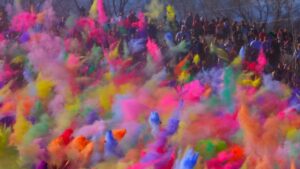Table of Contents
INTRODUCTION
Holi is a traditional Hindu festival celebrated in India and other countries. It is also known as the “Festival of Colors” or the “Festival of Love.” The festival typically falls in the month of March, on the full moon day of the Hindu month of Phalguna.
It is a time of joy and merriment, when people gather with their friends and families to play with colors, dance, sing, and enjoy traditional sweets and delicacies. The festival marks the arrival of spring and is a celebration of the victory of good over evil, as well as the renewal of love and friendship.
During Holi, people smear each other with colored powders and water, play music and dance, and exchange greetings and gifts. It is a time for forgiveness, reconciliation, and strengthening relationships with loved ones.
The festival is also associated with various mythological stories and legends, including the story of Prahlad and Holika, which symbolizes the victory of good over evil.

REGIONAL NAME OF HOLI
Lathmaar – Barsana, Holi is known as Lathmaar Holi. The stick is in the hands of the women on this day and the men need to work a lot to save themselves from the immensely charged-up womenfolk.
Dulandi –
Holi receives this name in the state of Haryana. Here, bhabhi – the brother’s wife gets an upper hand on the day of Holi. And, devar’s – husband’s younger brothers need to watch out.
The bhabhi on this day gets a social sanction on Holi to beat their devars and make them pay the price of all the pranks they played on them for the entire year. Bhabhi’s roll up their saris in the form of a rope in mock rage, and give a good run to their devars.
In the evening, devars are supposed to bring sweets for their dear bhabhi.
Rangpanchami – People of Maharashtra commonly know this festival of colors by the name of Rangpanchami as the play of colors is reserved for the fifth day here. Locals of Maharashtra also know Holi as Shimga or Shimgo.
Basant Utsav – Holi by the name of Basant Utsav is celebrated with fervor in the state of West Bengal. The tradition of Vasantotsav, meaning Spring Festival was started by poet and Nobel laureate Rabindranath Tagore at Shantiniketan, the University he founded.
Dol Purnima –
Holi is also known by the name of Dol Purnima in West Bengal.
Early in the morning, on the Dol Purnima day students dress up in saffron-colored clothes and wear garlands of fragrant flowers. They sing and dance to the accompaniment of musical instruments presenting an enchanting view to the onlookers and a memory to cherish for years.
Hola Mohalla –
Holi gets this joyful name in the state of Punjab. The festival is celebrated in an entirely different manner, its meaning and significance also shifts a little here.
Hola Mohalla is actually an annual fair that is organized in a large scale at Anandpur Sahib in Punjab on the day following the festival of Holi. The practice of holding a fair of this kind was initiated by Guru Gobind Singh, the tenth Sikh guru. Purpose of the fair was to physically strengthen the Sikh community by holding military exercises and mock battles.
Shimgo – The funfilled and enthusiastic people of Goa know Holi by the name of Shimgo in their local dialect Konkani. Here too, people play with bright colors to welcome the arrival of spring. This is followed by rich, spicy chicken or mutton curry called shagoti and sweet preparations. Some people also know Holi by the name of Rangpanchami
Kaman Pandigai – In the state of Tamil Nadu, people worship Kaamadeva for his supreme sacrifice on the occasion of Holi. People know Holi by three different names Kaman Pandigai, Kamavilas, and Kama-Dahanam.
Phagu Purnima –
Phagu Purnima is another name for Holi where Phagu means the sacred red powder and Purnima or Pune is the full moon day, on which the festival ends.
In some places like Bihar, Holi is also known as Phagwa as it is celebrated in the later part of the month of Phalgun and the early part of Chaitra in the Hindu calendar. This corresponds to the English months of March-April.
Safety Guidelines
There are some general guidelines and safety tips that people are advised to follow to ensure that the celebrations are safe and enjoyable for everyone.
Here are some of them:
- Use safe and natural colors: It is advisable to use natural colors made from flowers, herbs, and other organic materials instead of synthetic or chemical colors, which can cause skin irritation, allergies, or other health problems.
- Avoid using water balloons or high-pressure water guns: Throwing water balloons or using high-pressure water guns can be dangerous and can cause injuries. Instead, use a water sprinkler or spray bottle for the water part of the celebration.
- Respect others’ boundaries: Holi is a festive occasion, but it is important to respect others’ boundaries and avoid forcing anyone to participate in the celebrations if they are not interested.
- Be mindful of the environment: Do not litter or pollute the surroundings with colors, water, or other materials. Use eco-friendly dyes and try to minimize water wastage during the celebrations.
- Follow COVID-19 safety protocols: In light of the COVID-19 pandemic, it is essential to follow the safety protocols recommended by health authorities, such as wearing masks, maintaining social distancing, and avoiding large gatherings.
- Celebrate responsibly: Holi is a time to celebrate, but it is important to do so responsibly and avoid any behavior that can harm oneself or others.
